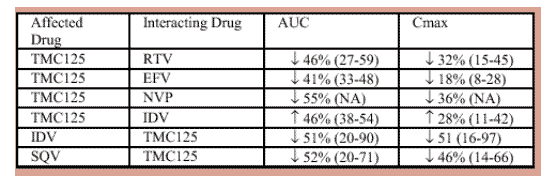 |
 |
 |
| |
TMC-125, a new NNRTI for patients with NNRTI resistance: drug interactions with NNRTIs and protease inhibitors
|
| |
| |
Here is information reported in 2 posters presented at ICAAC (Sept 2002) reporting results from early interaction studies between TMC-125 and other NNRTIs and protease inhibitors including Kaletra (lopinavir/ritonavir). TMC-125 has been shown to be potent and effective against virus resistant to NNRTIs. So this drug is in early clinical development and has potential to be effective for patients with resistance to efavirenz, nevirapine, and delavirdine.
TMC-125, a diarylpyrimidine derivative, is a next-generation NNRTI that has demonstrated potent anti-HIV activity in treatment - naive and NNRTI-resistant patients. The pharmacokinetics of TMC125 are characterized by a long half-life and hepatic metabolism. Phase I studies were performed to describe its drug interaction profile in healthy volunteers, and here are results.
The clinical development of new NNRTIs involves extensive evaluation of drug-drug interactions. TMC125 is an investigational next-generation NNRTI that achieves trough plasma concentrations well in excess of the IC 50 for wild type and NNRTI-resistant viruses. Steady-state is achieved within 7 days and TMC125 does not induce or inhibit its own metabolism. The metabolism of TMC125 involves both cytochrome P450 3A4 and
glucuronidation. A long half-life allows for twice daily dosing with small fluctuations in plasma levels during the dosing interval.
Studies examining the effect of efavirenz (EFV) and nevirapine (NVP) evaluated single doses of TMC125 at 900 mg before and after 14 days of EFV (n=12) or NVP (n=5). A single dose of TMC125 400 mg was also given before and after ritonavir (RTV) escalated to 600 mg bid (n=11). Saquinavir (SQV) was administered as a single dose of 1200 mg before and following 14 days of TMC125 at 900 mg bid (n=12).
Indinavir (IDV) 800 mg tid was evaluated with TMC125 1600 mg bid with both drugs dosed to steady-state (n=10).
Data shown in table below are mean % change (90% CI). NA = not available due to limited sample size.
TMC125 is an inducer of CYP3A4. The metabolism of TMC125 is moderately reduced by pure CYP3A4 inhibitors (i.e, IDV) and increased by CYP3A4 inducers (i.e., NVP). Full dose RTV, known to inhibit CYP3A4, and to induce glucuronidation, leads to decreased exposure of TMC125, which suggests glucuronidation as another metabolic pathway.
Author's Conclusions
TMC125 decreases concentrations of indinavir and saquinavir, most likely through the induction of CYP3A4.Indinavir increases exposure to TMC125. Most likely this is caused by inhibition of CYP3A4 by indinavir.
Indinavir increases exposure to TMC125. Most likely this is caused by inhibition of CYP3A4by indinavir.
Nevirapine and efavirenz decrease exposure to TMC125.
Full dose RTV known to induce glucuronidation, leads to decreased exposure of TMC125, which suggests glucuronidation as another metabolic pathway of TMC125
|
|
 |
| |
TMC-125 plus Kaletra: no interaction
TMC125, a diarylpyrimidine derivative, is a next generation NNRTI with potent anti-HIV activity against wild type and NNRTI-resistant strains (EC 50 = 0.6 ng/ml). This trial evaluated the bi-directional drug interaction potential between TMC125 and LPV/RTV (Kaletra ), both at steady-state.
The clinical development of new NNRTIs involves extensive evaluation of drug-drug interactions. TMC125 is an investigational next generation NNRTI with potent anti-HIV activity against wild type and NNRTI-resistant strains. The metabolism of TMC125 involves both cytochrome P450 3A4 and glucuronidation. Phase 1 trials have demonstrated that TMC125 induces CYP3A4 as evidenced by reduced concentrations of indinavir and saquinavir when used alone (see above report). Co-administration of TMC125 with full-dose ritonavir resulted in a decrease of the TMC125 AUC by 46%, likely due to induction effects of glucuronidation by ritonavir. This study was performed to evaluate the drug interaction between TMC125 and LPV/RTV.
Study methods: Open label, one sequence study in two parallel groups of 15 healthy male subjects. All subjects received a single dose of 400/100 mg LPV/RTV on day 1. After a washout period of at least 3 days, subjects in Panel 1 received 1600 mg TMC125 b.i.d. for 7 days immediately followed by combined administration of 1600 mg TMC125 b.i.d. and 400/100 mg LPV/RTV b.i.d. for 13 days (days 8 to 20), with an additional morning
dose of both drugs on day 21. Panel 2 received 400/100 mg LPV/RTV b.i.d. alone for 13 days, with an additional morning dose of LPV/RTV on day 14. Serial samples were collected on days 1, 7, and 21 for Panel 1 and days 1 and 14 for Panel 2.
Results: Pharmacokinetics of LPV or RTV did not differ between panels on day 1, demonstrating the comparability of the 2 parallel groups. Co-administration of TMC-125 and LPV/RTV for 14 days resulted in a non-significant increase in TMC125 AUC12hour of 17%, Cmax of 15% and Cmin of 23%. Mean AUC12h, Cmax, and Cmin for LPV was decreased by 19%, 15% and 8%, respectively, in subjects taking TMC-125 compared to the group taking LPV/RTV alone (p=NS). Mean pharmacokinetic values for RTV after 14 days of treatment were also not significantly different between groups. Under combined intake, the most common adverse events were diarrhea, hypercholesterolemia, and headache.
Conclusions: TMC125 does not significantly alter the pharmacokinetics of LPV/RTV in healthy volunteers. In addition, TMC125 exposure was not significantly different when combined with LPV/RTV compared to TMC125 alone. These data suggest that no dosage adjustment is required when TMC125 1600mg b.i.d. is co-administered with LPV/RTV. No deaths or serious adverse events were reported. One subject was withdrawn due to elevated LFTs that began in Session I.
|
|
| |
|
 |
 |
|
|